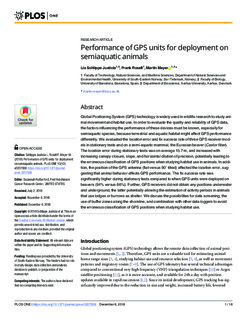| dc.contributor.author | Justicia, Lia Schlippe | |
| dc.contributor.author | Rosell, Frank | |
| dc.contributor.author | Mayer, Martin | |
| dc.date.accessioned | 2019-02-19T11:50:25Z | |
| dc.date.available | 2019-02-19T11:50:25Z | |
| dc.date.created | 2019-02-04T12:57:39Z | |
| dc.date.issued | 2018 | |
| dc.identifier.citation | PLoS ONE. 2018. | nb_NO |
| dc.identifier.issn | 1932-6203 | |
| dc.identifier.uri | http://hdl.handle.net/11250/2586234 | |
| dc.description | This is an open access article distributed under the terms of the Creative Commons Attribution License, which permits unrestricted use, distribution, and reproduction in any medium, provided the original author and source are credited. | nb_NO |
| dc.description.abstract | Global Positioning System (GPS) technology is widely used in wildlife research to study animal movement and habitat use. In order to evaluate the quality and reliability of GPS data, the factors influencing the performance of these devices must be known, especially for semiaquatic species, because terrestrial and aquatic habitat might affect GPS performance differently. We evaluated the location error and fix success rate of three GPS receiver models in stationary tests and on a semi-aquatic mammal, the Eurasian beaver (Castor fiber). The location error during stationary tests was on average 15.7 m, and increased with increasing canopy closure, slope, and horizontal dilution of precision, potentially leading to the erroneous classification of GPS positions when studying habitat use in animals. In addition, the position of the GPS antenna (flat versus 90˚ tilted) affected the location error, suggesting that animal behavior affects GPS performance. The fix success rate was significantly higher during stationary tests compared to when GPS units were deployed on beavers (94% versus 86%). Further, GPS receivers did not obtain any positions underwater and underground, the latter potentially allowing the estimation of activity periods in animals that use lodges or burrows as shelter. We discuss the possibilities for data screening, the use of buffer zones along the shoreline, and combination with other data loggers to avoid the erroneous classification of GPS positions when studying habitat use. | nb_NO |
| dc.language.iso | eng | nb_NO |
| dc.rights | Navngivelse 4.0 Internasjonal | * |
| dc.rights.uri | http://creativecommons.org/licenses/by/4.0/deed.no | * |
| dc.title | Performance of GPS units for deployment on semiaquatic animals | nb_NO |
| dc.type | Journal article | nb_NO |
| dc.type | Peer reviewed | nb_NO |
| dc.description.version | publishedVersion | nb_NO |
| dc.rights.holder | © 2018 Schlippe Justicia et al. | nb_NO |
| dc.source.pagenumber | 16 | nb_NO |
| dc.source.journal | PLoS ONE | nb_NO |
| dc.identifier.doi | 10.1371/journal.pone.0207938 | |
| dc.identifier.cristin | 1673050 | |
| cristin.unitcode | 222,58,1,0 | |
| cristin.unitname | Institutt for natur, helse og miljø | |
| cristin.ispublished | true | |
| cristin.fulltext | original | |
| cristin.qualitycode | 1 | |

